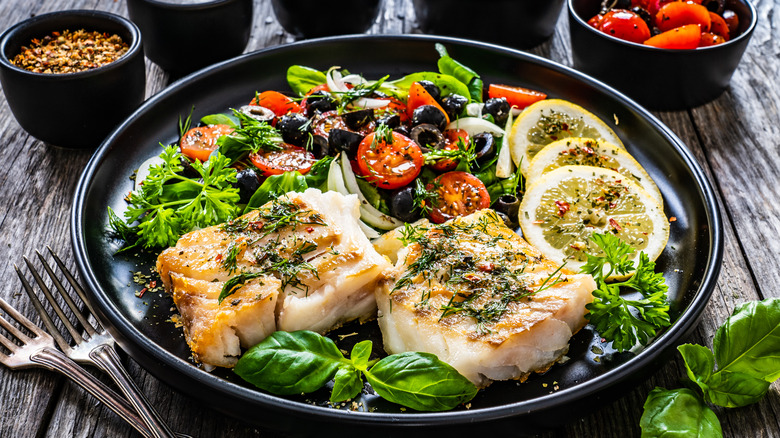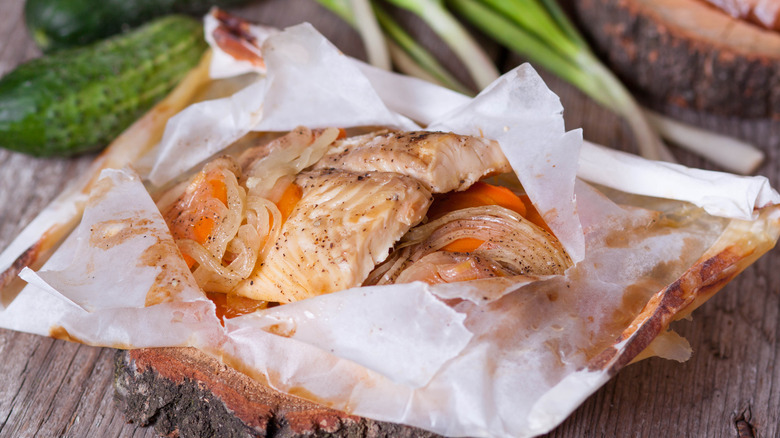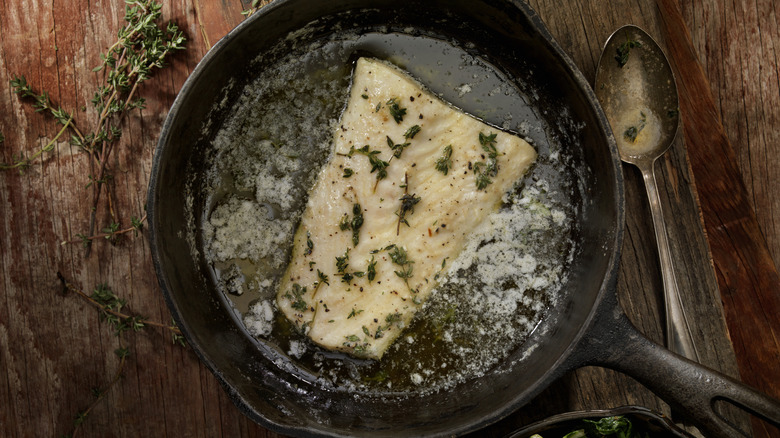What's The Best Way To Cook Fresh Halibut?
Halibut is one of the most nutritious fish on the market, offering over 38 grams of protein per serving. Plus, it's low in fat and high in vitamin D, potassium, phosphorus, and magnesium. Selenium, one of its essential nutrients, supports immune function and thyroid health while helping your body produce enzymes, proteins, and hormones. Moreover, halibut is lower in mercury than Spanish mackerel, shark, tilefish, swordfish, and albacore tuna.
From a culinary standpoint, this flatfish cooks relatively quickly and has a mild flavor that won't overpower other ingredients. It can be a perfect addition to salads, tacos, French bouillabaisse, grilled veggies, and stews, but it also tastes good on its own. Additionally, this easy halibut ceviche and other dishes are ideal for feeding large crowds and look simply spectacular.
However, halibut can be tricky to cook because of its delicate texture. Crank the heat too high, and the fish will lose its moisture and become dry. On top of that, halibut fillets vary in thickness, which makes it difficult to cook them evenly. You can bake, grill, poach, or steam fresh halibut, but the best way to cook it without drying it out is "en papillote."
How to cook halibut en papillote for optimal tenderness
Cooking food en papillote requires wrapping it in parchment paper or aluminum foil and baking it in the oven. This culinary technique allows the fish or meat to cook in its juices while retaining moisture and flavor. Since it ensures even cooking, it's ideal for baking fillets of different sizes. Plus, you can add herbs, spices, or veggies inside the package to customize the dish to your liking.
First, preheat your oven to 375 F. In the meantime, cut out a large square of parchment paper and place a halibut fillet on it. Season with salt and pepper, add some lemon slices, and scatter 4-5 cherry tomatoes cut into halves around the fillet. Drizzle olive oil over the fish, add thyme, rosemary, or other herbs, and fold the paper over the fillet. Make sure the package is tightly sealed. Last, place the parchment packet on a baking sheet and cook for about 15 minutes. The thicker the fillet, the longer it will take to cook.
Again, this culinary technique leaves a lot of room for creativity. You can pair the fish with olives, zucchinis, mushrooms, or beans, add fresh or dried herbs, and season with balsamic vinegar or Chardonnay. Halibut goes well with butter, leeks, fennel, thyme, and other flavorful ingredients. Similarly, you can cook salmon or chicken en papillote to preserve its moisture and save time in the kitchen.
Fry the halibut for extra crispiness
Halibut can lose its flavor and become dry when cooked for too long or at high temperatures. Your best bet is to fry it in butter or oil for 5-10 minutes, which reduces the risk of overcooking. Place the fillets on a paper towel, pat them dry, and then season them with salt, pepper, garlic powder, and herbs. Alternatively, marinate them in olive oil, white wine, and spices for a few hours or overnight.
Next, heat a nonstick pan greased with butter. Add the fillets in a single layer and fry them for up to five minutes on each side without moving them around. Once cooked, they should have a nice golden-brown color. Fry them in a cast iron pan rather than nonstick for extra crispiness. Serve the halibut with tahini sauce, green beans, or steamed veggies for a filling, nutritious meal.
Another option is to bake the halibut fillets for 15-20 minutes, depending on their thickness. For starters, try this pecan-crusted halibut recipe, which is just perfect for when you're short on time. You can also coat the fish in flour and eggs, parmesan, almonds, pistachios, or panko bread crumbs to give it a crispy crust. Serve it with a light salad and capers for a Mediterranean touch.


